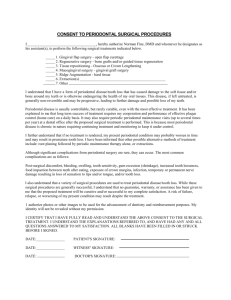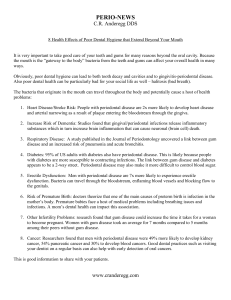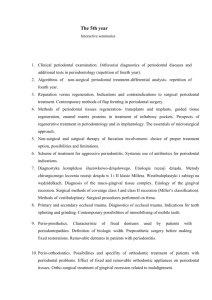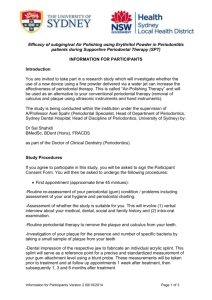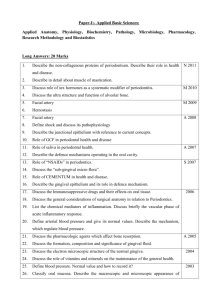Paper-III - periobasics.com
advertisement
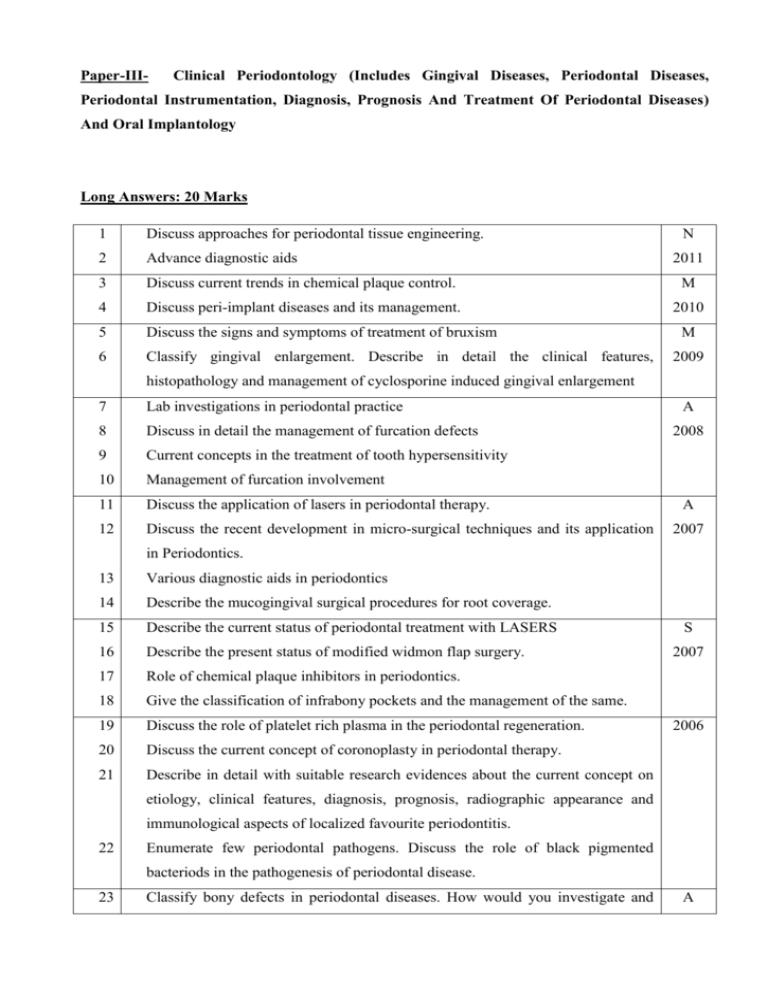
Paper-III- Clinical Periodontology (Includes Gingival Diseases, Periodontal Diseases, Periodontal Instrumentation, Diagnosis, Prognosis And Treatment Of Periodontal Diseases) And Oral Implantology Long Answers: 20 Marks 1 Discuss approaches for periodontal tissue engineering. N 2 Advance diagnostic aids 3 Discuss current trends in chemical plaque control. M 4 Discuss peri-implant diseases and its management. 2010 5 Discuss the signs and symptoms of treatment of bruxism 6 Classify gingival enlargement. Describe in detail the clinical features, 2011 M 2009 histopathology and management of cyclosporine induced gingival enlargement 7 Lab investigations in periodontal practice 8 Discuss in detail the management of furcation defects 9 Current concepts in the treatment of tooth hypersensitivity 10 Management of furcation involvement 11 Discuss the application of lasers in periodontal therapy. 12 Discuss the recent development in micro-surgical techniques and its application A 2008 A 2007 in Periodontics. 13 Various diagnostic aids in periodontics 14 Describe the mucogingival surgical procedures for root coverage. 15 Describe the current status of periodontal treatment with LASERS 16 Describe the present status of modified widmon flap surgery. 17 Role of chemical plaque inhibitors in periodontics. 18 Give the classification of infrabony pockets and the management of the same. 19 Discuss the role of platelet rich plasma in the periodontal regeneration. 20 Discuss the current concept of coronoplasty in periodontal therapy. 21 Describe in detail with suitable research evidences about the current concept on S 2007 2006 etiology, clinical features, diagnosis, prognosis, radiographic appearance and immunological aspects of localized favourite periodontitis. 22 Enumerate few periodontal pathogens. Discuss the role of black pigmented bacteriods in the pathogenesis of periodontal disease. 23 Classify bony defects in periodontal diseases. How would you investigate and A establish the prognosis of the defect. 24 Discuss the influence of the female sex hormones over the periodontium. 25 Discuss the current concepts of management of gingival recession. 26 Discuss the rationale and limitations of periodontal therapy during pregnancy. 27 Discuss the merits and demerits of ultrasonics in periodontal therapy. 28 Discuss the use of lasers in periodontal therapy. 29 Define anti-microbials. Write in detail about various forms, its use in periodontal 2005 2004 2003 pocket therapy. 30 Management of primary trauma from occlusion. 31 Discuss the microbiological profile of localised juvenile periodontitis and its recent advances. 32 Discuss the influence of systemic diseases on the periodontium. 33 New attachment procedures. 34 Management of primary trauma from occlusion – in detail. 35 Role of genetic influence in the aetiology of periodontal diseases. 36 What is bio-film. Describe the current trends on biofilm in periodontal diseases. 37 Discuss the recent developments of reconstructive periodontal osseous surgery. 38 Discuss the biologic aspects of dental implants. 39 Discuss the role of antimicrobial agents in the management of periodontal 2002 diseases. 40 Discuss the role of saliva in health and disease. 41 Discuss the indications and limitations of surgical approaches to increase the 2001 zone of attach gingiva. 42 Define and classify periodontal splints. Give its indications, role and biophysical principles. 43 Discuss the microbial specificity with reference to periodontal diseases. 44 Discuss the influence of female sex hormones over the periodontium. 45 Discuss recent advances in periodontal diagnosis 46 Discuss the biologic principles of guided periodontal tissue regeneration. Short Answers: 1. Management of Halitosis 2. Antioxidents 3. Citric acid and fibronectin in periodontal therapy N 2011 4. Subantimicrobial dose doxycycline 5. Probiotics 6. Crown lengthening 7. Host modulation therapy in periodontal therapy 8. Current concepts in root biomodification 9. Complications following flap surgery M 2010 10. Current status of alloplasts in periodontal regeneration 11. Explain wound healing in furcation defects 12. Explain the factors which influences prognosis and treatment plan in periodontal diseases 13. Classification of various bone grafting materials M 2009 14. Periodontal pockets 15. Prognosis 16. Gingivectomy technique 17. Halitosis and its management 18. Vestibular extension procedure with its indications 19. Evidence based periodontal therapy A 2008 20. Chlorhexidine 21. Operating microscope 22. Electro surgery 23. Supportive periodontal treatment 24. Ortho-perio inter-relationship 25. Results of periodontal treatment 26. Materials used in GTR 27. Splints in periodontal therapy 28. DNA probe 29. Ultrasonics in periodontal therapy 30. Maintenance schedule for the implant patient 31.Role of reactive oxygen species in Periodontitis 32. Status of growth factors in periodontal regeneration 33. Drawbacks of crown lengthening procedures 34. Chronic desquamative gingivitis 35. Immediate implants 36. Coronoplasty 37. Factors responsible for failure of periodontal therapy A 2007 38. Describe supportive periodontal therapy in brief 39. Explain the use of electro surgery in periodontics 40. Recent advances of periodontal surgery 41. Periodontal dressing materials 42. Indications of dental implants 43. Alendronate S 2007 44. Powered tooth brush 45. Root biomodification 46. Osteoplasty 47. Periodontal probes 48. Allografts 49. Describe any 1 vestibular extension procedures along with its indication. 50. Explain the role of patient motivation in preventive periodontics. 51. How laser can be best used in periodontal therapy? 52. Classification of various bone grafting materials. 53. Explain the procedure of respective osseous surgery. 54. Peri-implant complications. 55. Implant-bone interface 56. FGG 57. Enamel matrix derivatives 58. Ey:YAG laser 59. Undisplaced flap surgery 60. Microsurgical instruments 61. Enumerate and discuss the causes and management of various acute gingival lesions 62. Periodontal disease – a risk factor for preterm low birth weight. 63. Periodontal manifestation of diabetic patient 64. Periodontal disease activity with special emphesis on gram negative anaerobes 65. Genetic factors in periodontal disease 66. Animal experiments in periodontal research 67. Discuss the keys technique as therapeutic approach in the management of periodontal disease. 68. Discuss the objectives and indications to Occlusal adjustment in periodontal therapy 69. Use of lasers in periodontal therapy 70. Tooth brushes used for plaque control 71. Various disclosing agents 2006 72. Treatment of gingival enlargement in pregnancy 73. Discuss the maintenance phase after implants. A 2005 74. Difference between pocket and clinical attachment loss- your views. 75. Role of interlukin-1 in periodontal health and disease. 76. Merits and demerits of ultrasonics in periodontal therapy. 77. Role of systemic antibiotics in periodontal therapy. 78. Discuss the importance of adequate width of attached gingiva. 79. Clinical aspects of dental implants 2004 80. Difference between pocket depth and attachment level- your views 81. Chemically modified tetracycline 82. Treatment of chronic desquamative gingivitis 83. Crown lengthening procedure 84. Biology of periodontal wound healing. 85. Advanced diagnostic aids in Periodontics 2003 86. Discuss the various factors influencing prognosis and treatment planning in patients of chronic periodontal diseases. 87. Discuss the role of splints in the periodontal therapy. 88. How would you manage a case of acute necrotizing ulcerative gingivitis? 89. How does the periodontal ligamens functionally adapt to masticatory forces. 90. Discuss the role of tranquilizers and sedatives as adjuncts in periodontal therapy. 91. Papilla preservation flap surgery 92. Management of grade- II and III furcation with vertical defects. 93. Halitosis- its therapy 94. Autogenous osseous grafts 95. Pulpo-periodontal lesions 96. Acute herpatic gingivostomatitis diagnosis and management. 97. Basic concepts of host response 98. Macrophages in periodontal health and disease 99. Food impaction and periodontal health 100. Bruxism and periodontal health 101. Gingival bleeding 102. Etiopathogenesis of drug induced gingival enlargement 103. BMPs- basis and clinical applications 104. Management of grade- III and IV furcation involvement 105. Chemical plaque control in periodontal therapy 2002 106. Decision making in periodontal therapy 107. Aesthetic gingival contouring 108. Osseous respective surgery 109. TFO 110. Periodontal disease as a risk factor for systemic diseases. 111. Drug indused gingival enlargemet. 112. GCF as a marker of periodontal destruction. 113. BMPs 114. Complement activation- its role in the pathogenesis of periodontal disease. 115. Discuss the formation, composition and attachment of dental plaque. 116. Describe bacteriology of periodontal pocket. 117. Describe the current concept on the pathogenesis of localised juvenile periodontitis. 118. State the role of systemic conditions modifying the clinical appearance of periodontal tissue in detail. 119. Discuss the role of IL-1 in periodontal health and disease 120. Discuss the role of tobacco in periodontal disease. 121. Periodontal surgery under magnification. 122. Criteria for selection of mucogingival techniques. 123. Treatment of chronic desquamative gingivitis 124. Treatment od denuded roots 125. Historical development of modified widmon’s flap surgery 126. Root planning versus gingival curettage. 127. Pathogenesis and management of furcation involvement in periodontal disease. 128. Discuss interdisciplinary approaches and relationships in Periodontics. 129. Discuss the management of periodontal problems in patients with high risk factors. 130. Periodontal lesions are healing lesions. – in the light of above statement evaluate the management of early periodontitis. 131. Rational of using local drug delivery system. 132. How will you manage a case of disquamative gingivitis? 133. Discuss the acute periodontal lesions 134. Classify bony defects. How would you investigate and established prognosis of such defect? 135. Describe attachment of dental calculus. 136. Describe hormonal influences on periodontium during pregnancy. 137. Discuss protective component of saliva. 2001 138. Discuss the current concept as regards the etiology of prepubertal periodontitis. 139. Implant- bone interface 140. Periodontal microsurgery 141. Papilla preservation flap 142. Alloplastic bone graft substitutes 143. Coronoplasty in periodontal therapy 144. Free soft tissue autograft





